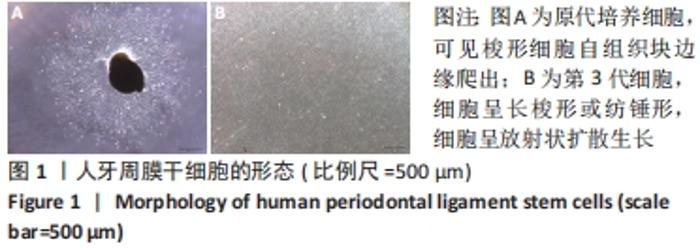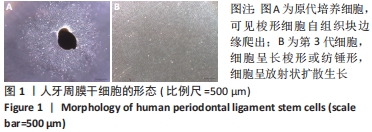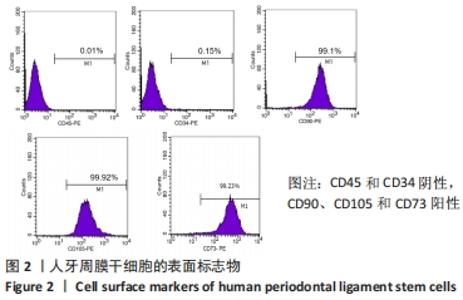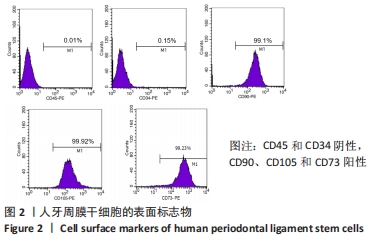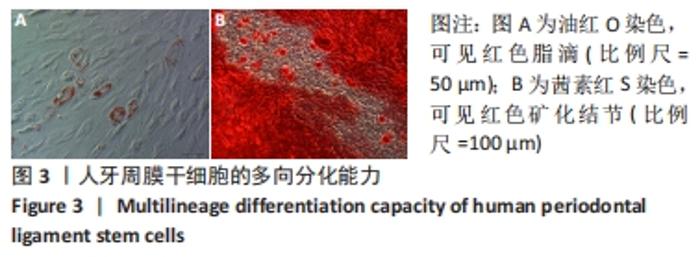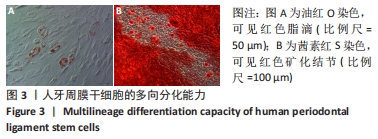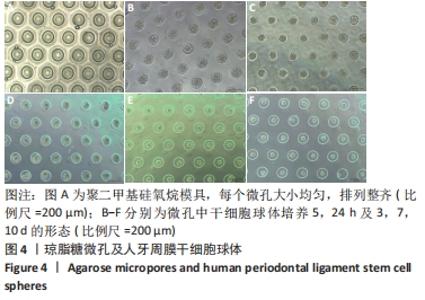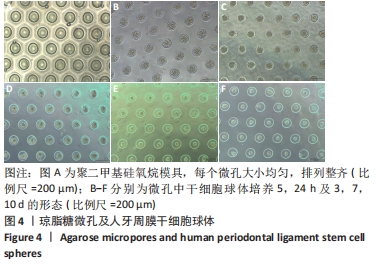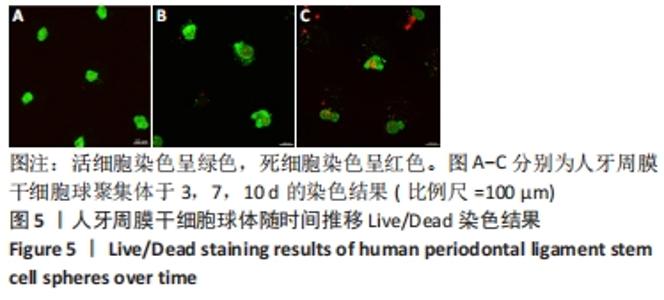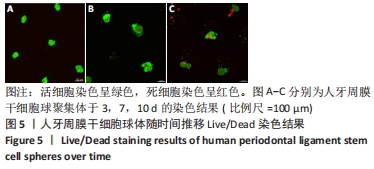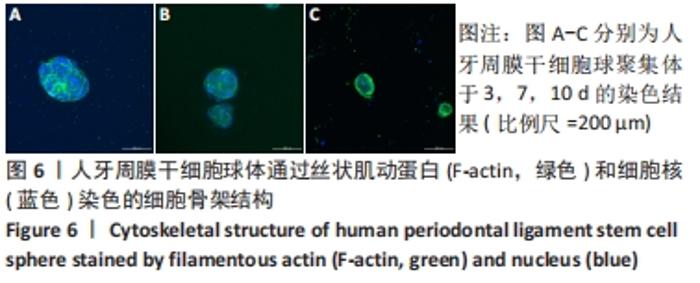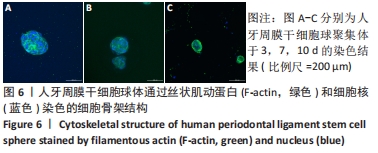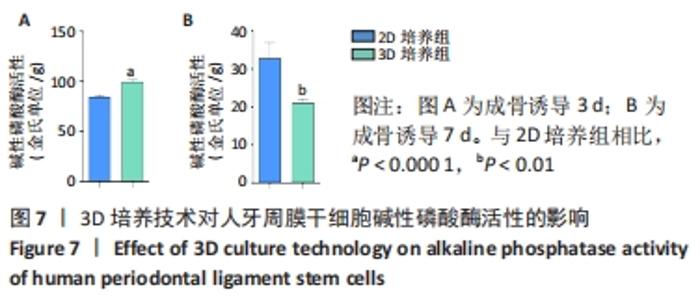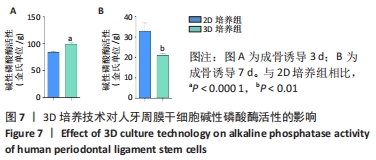Chinese Journal of Tissue Engineering Research ›› 2023, Vol. 27 ›› Issue (6): 846-852.doi: 10.12307/2023.221
Previous Articles Next Articles
Three-dimensional culture affects morphology, activity and osteogenic differentiation of human periodontal ligament stem cells
Li Xinyue1, Li Xiheng1, Mao Tianjiao2, Tang Liang1, Li Jiang1, 2
- 1Department of Prosthodontics, Stomatology Hospital, Jilin University, Changchun 130021, Jilin Province, China; 2Department of Prosthodontics, Affiliated Stomatology Hospital, Guangzhou Medical University, Guangzhou 510150, Guangdong Province, China
-
Received:2021-12-30Accepted:2022-02-24Online:2023-02-28Published:2022-08-10 -
Contact:Li Jiang, Chief physician, Professor, Doctoral supervisor, Department of Prosthodontics, Stomatology Hospital, Jilin University, Changchun 130021, Jilin Province, China; Department of Prosthodontics, Affiliated Stomatology Hospital, Guangzhou Medical University, Guangzhou 510150, Guangdong Province, China -
About author:Li Xinyue, Master candidate, Department of Prosthodontics, Stomatology Hospital, Jilin University, Changchun 130021, Jilin Province, China
CLC Number:
Cite this article
Li Xinyue, Li Xiheng, Mao Tianjiao, Tang Liang, Li Jiang. Three-dimensional culture affects morphology, activity and osteogenic differentiation of human periodontal ligament stem cells[J]. Chinese Journal of Tissue Engineering Research, 2023, 27(6): 846-852.
share this article
Add to citation manager EndNote|Reference Manager|ProCite|BibTeX|RefWorks
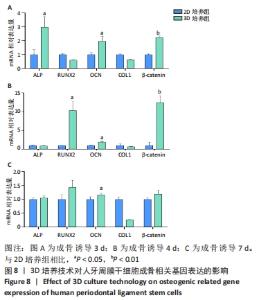
2.6.2 成骨基因表达 成骨诱导3,4,7 d时,通过qRT-PCR检测细胞成骨相关基因ALP、RUNX2、OCN和COL1的mRNA表达。如图8所示,成骨诱导3 d时,与2D培养相比,3D培养组ALP、OCN mRNA表达水平均显著上调(P < 0.05)。成骨诱导4 d时,与2D培养组相比,3D培养组RUNX2、OCN mRNA表达水平显著上调(P < 0.05)。成骨诱导7 d时,与2D培养组相比,3D培养组RUNX2、OCN mRNA表达水平显著上调,仅OCN基因有统计学意义(P < 0.05)。此外,还分析了β-catenin的mRNA表达水平以评估3D培养技术对Wnt/β-catenin信号通路的影响。如图8所示,在成骨诱导3,4 d时β-catenin的mRNA表达水平显著上调(P < 0.01),成骨诱导7 d时也存在上调趋势。"
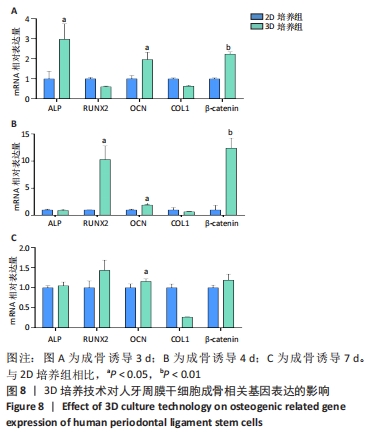
| [1] ANDRZEJEWSKA A, LUKOMSKA B, JANOWSKI M. Concise Review: Mesenchymal Stem Cells: From Roots to Boost. Stem Cells. 2019;37(7): 855-864. [2] PITTENGER MF, DISCHER DE, PÉAULT BM, et al. Mesenchymal stem cell perspective: cell biology to clinical progress. NPJ Regen Med. 2019;4:22. [3] BUDURU SD, GULEI D, ZIMTA AA, et al. The Potential of Different Origin Stem Cells in Modulating Oral Bone Regeneration Processes. Cells. 2019;8(1):29. [4] ZHAO SJ, KONG FQ, JIE J, et al. Macrophage MSR1 promotes BMSC osteogenic differentiation and M2-like polarization by activating PI3K/AKT/GSK3β/β-catenin pathway. Theranostics. 2020;10(1):17-35. [5] ROGERS CJ, HARMAN RJ, BUNNELL BA, et al. Rationale for the clinical use of adipose-derived mesenchymal stem cells for COVID-19 patients. J Transl Med. 2020;18(1):203. [6] MARINO L, CASTALDI MA, ROSAMILIO R, et al. Mesenchymal Stem Cells from the Wharton’s Jelly of the Human Umbilical Cord: Biological Properties and Therapeutic Potential. Int J Stem Cells. 2019;12(2):218-226. [7] HUANG X, CHENG B, SONG W, et al. Superior CKIP-1 sensitivity of orofacial bone-derived mesenchymal stem cells in proliferation and osteogenic differentiation compared to long bone-derived mesenchymal stem cells. Mol Med Rep. 2020;22(2):1169-1178. [8] PAN J, DENG J, YU L, et al. Investigating the repair of alveolar bone defects by gelatin methacrylate hydrogels-encapsulated human periodontal ligament stem cells. J Mater Sci Mater Med. 2019;31(1):3. [9] ZHAO Z, LIU J, WEIR MD, et al. Human periodontal ligament stem cells on calcium phosphate scaffold delivering platelet lysate to enhance bone regeneration. RSC Adv. 2019;9:41161-41172. [10] LUKOMSKA B, STANASZEK L, ZUBA-SURMA E, et al. Challenges and Controversies in Human Mesenchymal Stem Cell Therapy. Stem Cells Int. 2019;2019:9628536. [11] SUI BD, HU CH, LIU AQ, et al. Stem cell-based bone regeneration in diseased microenvironments: Challenges and solutions. Biomaterials. 2019;196:18-30. [12] ZHENG C, CHEN J, LIU S, et al. Stem cell-based bone and dental regeneration: a view of microenvironmental modulation. Int J Oral Sci. 2019;11(3):23. [13] SATO T, ANADA T, HAMAI R, et al. Culture of hybrid spheroids composed of calcium phosphate materials and mesenchymal stem cells on an oxygen-permeable culture device to predict in vivo bone forming capability. Acta Biomater. 2019;88:477-490. [14] QIAO Y, XU Z, YU Y, et al. Single cell derived spheres of umbilical cord mesenchymal stem cells enhance cell stemness properties, survival ability and therapeutic potential on liver failure. Biomaterials. 2020;227:119573. [15] KIM J, ADACHI T. Cell-fate decision of mesenchymal stem cells toward osteocyte differentiation is committed by spheroid culture. Sci Rep. 2021;11(1):13204. [16] JAUKOVIĆ A, ABADJIEVA D, TRIVANOVIĆ D, et al. Specificity of 3D MSC Spheroids Microenvironment: Impact on MSC Behavior and Properties. Stem Cell Rev Rep. 2020;16(5):853-875. [17] RYU NE, LEE SH, PARK H. Spheroid Culture System Methods and Applications for Mesenchymal Stem Cells. Cells. 2019;8(12):1620. [18] NILSSON HALL G, MENDES LF, GKLAVA C, et al. Developmentally Engineered Callus Organoid Bioassemblies Exhibit Predictive In Vivo Long Bone Healing. Adv Sci (Weinh). 2019;7(2):1902295. [19] LEIJTEN J, TEIXEIRA LS, BOLANDER J, et al. Bioinspired seeding of biomaterials using three dimensional microtissues induces chondrogenic stem cell differentiation and cartilage formation under growth factor free conditions. Sci Rep. 2016;6:36011. [20] SEO BM, MIURA M, GRONTHOS S, et al. Investigation of multipotent postnatal stem cells from human periodontal ligament. Lancet. 2004; 364(9429):149-155. [21] NUÑEZ J, VIGNOLETTI F, CAFFESSE RG, et al. Cellular therapy in periodontal regeneration. Periodontol 2000. 2019;79(1):107-116. [22] 瞿思维,薛亚楠,李萍,等.干细胞组织工程化的研究进展[J].中华烧伤杂志,2020,36(6):510-515. [23] ONIZUKA S, IWATA T. Application of Periodontal Ligament-Derived Multipotent Mesenchymal Stromal Cell Sheets for Periodontal Regeneration. Int J Mol Sci. 2019;20(11):2796. [24] IWATA T, YAMATO M, WASHIO K, et al. Periodontal regeneration with autologous periodontal ligament-derived cell sheets - A safety and efficacy study in ten patients. Regen Ther. 2018;9:38-44. [25] XU XY, LI X, WANG J, et al. Concise Review: Periodontal Tissue Regeneration Using Stem Cells: Strategies and Translational Considerations. Stem Cells Transl Med. 2019;8(4):392-403. [26] YU SJ, CHOI G, CHO Y, et al. Three-Dimensional Spheroid Culture on Polymer-Coated Surface Potentiate Stem Cell Functions via Enhanced Cell-Extracellular Matrix Interactions. ACS Biomater Sci Eng. 2020;6(4):2240-2250. [27] 何云影,李玲婕,张舒淇,等.聚丙烯酸/琼脂糖三维培养构建细胞球的方法[J].中国组织工程研究,2022,26(4):553-559. [28] DI STEFANO AB, MONTESANO L, BELMONTE B, et al. Human Spheroids from Adipose-Derived Stem Cells Induce Calvarial Bone Production in a Xenogeneic Rabbit Model. Ann Plast Surg. 2021;86(6):714-720. [29] IWASAKI K, NAGATA M, AKAZAWA K, et al. Changes in characteristics of periodontal ligament stem cells in spheroid culture. J Periodontal Res. 2019;54(4):364-373. [30] JEONG YY, KIM MS, LEE KE, et al. Comparison of 2-and 3-Dimensional Cultured Periodontal Ligament Stem Cells; a Pilot Study. Applied Sciences. 2021;11(3):1083. [31] PINTO B, HENRIQUES AC, SILVA PMA, et al. Three-Dimensional Spheroids as In Vitro Preclinical Models for Cancer Research. Pharmaceutics. 2020;12(12):1186. [32] MUKOMOTO R, NASHIMOTO Y, TERAI T, et al. Oxygen consumption rate of tumour spheroids during necrotic-like core formation. Analyst. 2020;145(19):6342-6348. [33] ZENG WY, NING Y, HUANG X. Advanced technologies in periodontal tissue regeneration based on stem cells: Current status and future perspectives. J Dent Sci. 2021;16(1):501-507. [34] BARISAM M, SAIDI MS, KASHANINEJAD N, et al. Prediction of Necrotic Core and Hypoxic Zone of Multicellular Spheroids in a Microbioreactor with a U-Shaped Barrier. Micromachines (Basel). 2018;9(3):94. [35] SEO Y, SHIN TH, KIM HS. Current Strategies to Enhance Adipose Stem Cell Function: An Update. Int J Mol Sci. 2019;20(15):3827. [36] EFREMOV YM, ZURINA IM, PRESNIAKOVA VS, et al. Mechanical properties of cell sheets and spheroids: the link between single cells and complex tissues. Biophys Rev. 2021;13(4):541-561. [37] BLUMLEIN A, WILLIAMS N, MCMANUS JJ. The mechanical properties of individual cell spheroids. Sci Rep. 2017;7(1):7346. [38] JANMEY PA, FLETCHER DA, REINHART-KING CA. Stiffness Sensing by Cells. Physiol Rev. 2020;100(2):695-724. [39] TIETZE S, KRÄTER M, JACOBI A, et al. Spheroid Culture of Mesenchymal Stromal Cells Results in Morphorheological Properties Appropriate for Improved Microcirculation. Adv Sci (Weinh). 2019;6(8):1802104. [40] SUNG TC, HEISH CW, LEE HC, et al. 3D culturing of human adipose-derived stem cells enhances their pluripotency and differentiation abilities. J Mater Sci Mater Med. 2021;63(4):9-17. [41] MORITANI Y, USUI M, SANO K, et al. Spheroid culture enhances osteogenic potential of periodontal ligament mesenchymal stem cells. J Periodontal Res. 2018;53(5):870-882. [42] NACHLINGER RJ, KAUSCHKE V, TRINKAUS K, et al. Application of donepezil increased collagen 1 expression in mesenchymal stroma cells of an ovine osteoporosis model. J Musculoskelet Neuronal Interact. 2018;18(3):354-365. [43] LEE SI, KO Y, PARK JB. Evaluation of the osteogenic differentiation of gingiva-derived stem cells grown on culture plates or in stem cell spheroids: Comparison of two- and three-dimensional cultures. Exp Ther Med. 2017;14(3):2434-2438. [44] KOMORI T. Regulation of Proliferation, Differentiation and Functions of Osteoblasts by Runx2. Int J Mol Sci. 2019;20(7):1694. [45] HAN Y, YOU X, XING W, et al. Paracrine and endocrine actions of bone-the functions of secretory proteins from osteoblasts, osteocytes, and osteoclasts. Bone Res. 2018;6:16. [46] ZUBILLAGA V, ALONSO-VARONA A, FERNANDES SCM, et al. Adipose-Derived Mesenchymal Stem Cell Chondrospheroids Cultured in Hypoxia and a 3D Porous Chitosan/Chitin Nanocrystal Scaffold as a Platform for Cartilage Tissue Engineering. Int J Mol Sci. 2020;21(3):1004. [47] STEINHART Z, ANGERS S. Wnt signaling in development and tissue homeostasis. Development. 2018;145(11):dev146589. [48] NIE F, ZHANG W, CUI Q, et al. Kaempferol promotes proliferation and osteogenic differentiation of periodontal ligament stem cells via Wnt/β-catenin signaling pathway. Life Sci. 2020;258:118143. [49] IMAMURA A, KAJIYA H, FUJISAKI S, et al. Three-dimensional spheroids of mesenchymal stem/stromal cells promote osteogenesis by activating stemness and Wnt/beta-catenin. Biochem Biophys Res Commun. 2020; 523(2):458-464. |
| [1] | Sun Kexin, Zeng Jinshi, Li Jia, Jiang Haiyue, Liu Xia. Mechanical stimulation enhances matrix formation of three-dimensional bioprinted cartilage constructs [J]. Chinese Journal of Tissue Engineering Research, 2023, 27(在线): 1-7. |
| [2] | Zhao Lu, Zhao Yifei, Gao Da, Liu Yanfang, Fu Tingting, Xu Jiangyan. Expression of suppressor of Zeste 12 in kidney tissues of rats with diabetic nephropathy [J]. Chinese Journal of Tissue Engineering Research, 2023, 27(8): 1179-1186. |
| [3] | Yang Zhishan, Tang Zhenglong. YAP/TAZ, a core factor of the Hippo signaling pathway, is involved in bone formation [J]. Chinese Journal of Tissue Engineering Research, 2023, 27(8): 1264-1271. |
| [4] | Xu Xingxing, Wen Chaoju, Meng Maohua, Wang Qinying, Chen Jingqiao, Dong Qiang. Carbon nanomaterials in oral implant [J]. Chinese Journal of Tissue Engineering Research, 2023, 27(7): 1062-1070. |
| [5] | Yang Yitian, Wang Lu, Yao Wei, Zhao Bin. Application of the interaction between biological scaffolds and macrophages in bone regeneration [J]. Chinese Journal of Tissue Engineering Research, 2023, 27(7): 1071-1079. |
| [6] | Li Cheng, Zheng Guoshuang, Kuai Xiandong, Yu Weiting. Alginate scaffold in articular cartilage repair [J]. Chinese Journal of Tissue Engineering Research, 2023, 27(7): 1080-1088. |
| [7] | Shi Yehong, Wang Cheng, Chen Shijiu. Early thrombosis and prevention of small-diameter blood vessel prosthesis [J]. Chinese Journal of Tissue Engineering Research, 2023, 27(7): 1110-1116. |
| [8] | Tang Haotian, Liao Rongdong, Tian Jing. Application and design of piezoelectric materials for bone defect repair [J]. Chinese Journal of Tissue Engineering Research, 2023, 27(7): 1117-1125. |
| [9] | Xu Yan, Li Ping, Lai Chunhua, Zhu Peijun, Yang Shuo, Xu Shulan. Piezoelectric materials for vascularized bone regeneration [J]. Chinese Journal of Tissue Engineering Research, 2023, 27(7): 1126-1132. |
| [10] | Yuan Wei, Liu Jingdong, Xu Guanghui, Kang Jian, Li Fuping, Wang Yingjie, Zhi Zhongzheng, Li Guanwu. Osteogenic differentiation of human perivascular stem cells and its regulation based on Wnt/beta-catenin signaling pathway [J]. Chinese Journal of Tissue Engineering Research, 2023, 27(6): 866-871. |
| [11] | Li Xiaoyin, Yang Xiaoqing, Chen Shulian, Li Zhengchao, Wang Ziqi, Song Zhen, Zhu Daren, Chen Xuyi. Collagen/silk fibroin scaffold combined with neural stem cells in the treatment of traumatic spinal cord injury [J]. Chinese Journal of Tissue Engineering Research, 2023, 27(6): 890-896. |
| [12] | Yuan Bo, Xie Lide, Fu Xiumei. Schwann cell-derived exosomes promote the repair and regeneration of injured peripheral nerves [J]. Chinese Journal of Tissue Engineering Research, 2023, 27(6): 935-940. |
| [13] | Qin Yuxing, Ren Qiangui, Li Zilong, Quan Jiaxing, Shen Peifeng, Sun Tao, Wang Haoyu. Action mechanism and prospect of bone microvascular endothelial cells for treating femoral head necrosis [J]. Chinese Journal of Tissue Engineering Research, 2023, 27(6): 955-961. |
| [14] | Liu Wentao, Feng Xingchao, Yang Yi, Bai Shengbin. Effect of M2 macrophage-derived exosomes on osteogenic differentiation of bone marrow mesenchymal stem cells [J]. Chinese Journal of Tissue Engineering Research, 2023, 27(6): 840-845. |
| [15] | Long Yanming, Xie Mengsheng, Huang Jiajie, Xue Wenli, Rong Hui, Li Xiaojie. Casein kinase 2-interaction protein-1 regulates the osteogenic ability of bone marrow mesenchymal stem cells in osteoporosis rats [J]. Chinese Journal of Tissue Engineering Research, 2023, 27(6): 878-882. |
| Viewed | ||||||
|
Full text |
|
|||||
|
Abstract |
|
|||||
